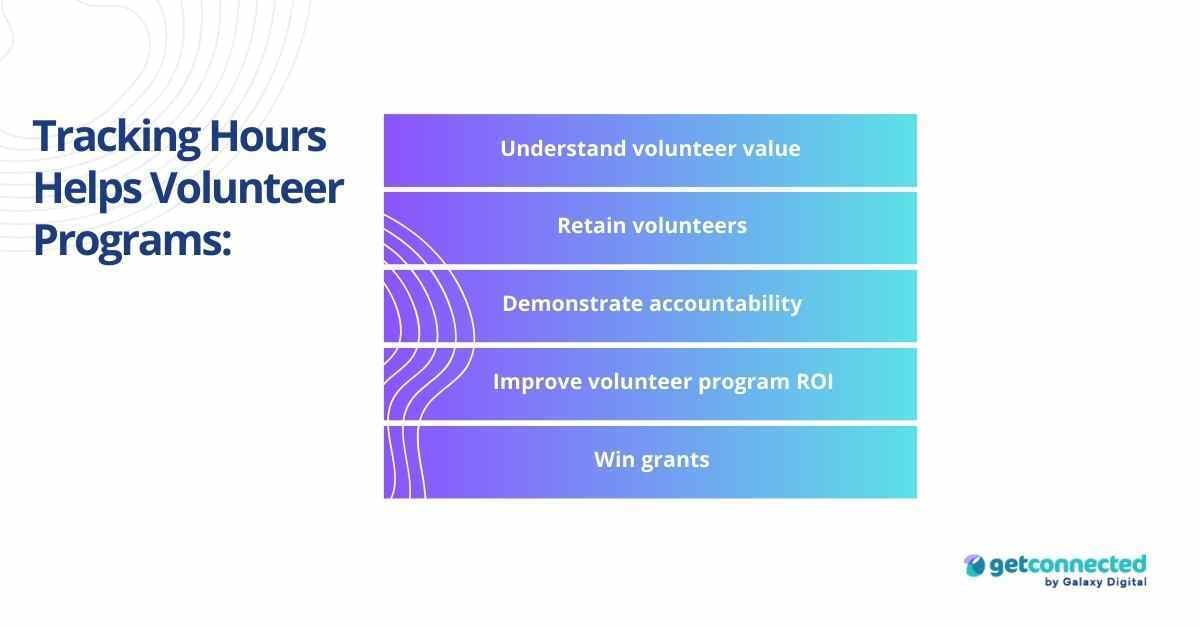Free Resource: volunteer hours log templates
In 2021, volunteers in the United States contributed over 4.1 billion hours of service. While that statistic alone is impressive in its own right, it actually provides a glimpse, too, into how important it is to track volunteer time.
Tracking volunteer hours, or the time your supporters spend on helping you progress your mission, helps your nonprofit understand their impact, retain those volunteers, and scale. But despite how important this information is, lots of organizations don’t know how to go about the process of tracking in the first place.
From spreadsheets to automated software, we’ll review how to track volunteer hours, including listing the best tools and strategies for logging volunteer time. We’ve also got a few free templates to get you started, too.
What Is a Volunteer Hours Log?
A volunteer hours log is a form, spreadsheet, or database used to record attendance and the amount of time each volunteer contributes to your program. Usually, this log includes information like:
- Volunteer name
- Volunteer contact information
- Check-in and check-out time
- Total hours worked
- Volunteer activity and role title

Why Do Nonprofits Track Volunteer Hours?
Volunteer logs serve as vital records that demonstrate volunteers’ contributions — which is beneficial for both your volunteers and your mission.
Tracking hours helps nonprofits:
- Understand volunteer value: According to the Independent Sector, the national value of a volunteer hour is $31.80. By understanding this impact, nonprofits can, as one volunteer coordinator noted, funnel more money into their mission. “We found that our volunteers contributed services worth over $500,000 last year. That's a substantial amount we didn't have to fundraise, allowing us to redirect resources to other essential areas."
- Retain volunteers: Tracking hours serves as both a motivator and a source of fulfillment for volunteers. When nonprofits can show volunteers just how important their contributions are, and how appreciated they are, the more likely they are to stay.
- Demonstrate accountability: Some community partners may require their volunteers' hours to be logged officially on behalf of the host organization. For example, your corporate partners may need proof of volunteer hours to support their employee volunteer time-off benefit.
- Improve program return on investment: Return on investment (ROI) isn't just a business term; it's a measure of the effectiveness of your volunteer program. By understanding where volunteers are most effective and where improvements can be made, you can optimize your program for maximum impact.
- Win grants: Most nonprofits rely on grants and other outside funding, and many foundations require these organizations to track and report on volunteer contributions. By logging volunteer hours, you’re more likely to secure the funding you need to support your program(s).
Free Download: Volunteer Hours Logs Templates
How Do I Keep Track of Volunteer Hours?
Tracking volunteer hours efficiently requires the right goals, strategies, and tools, as well as a few best practices.
1. Understand Objectives
Before diving into the nitty gritty of tracking hours, you’ll want to first understand the why behind tracking this information. To get a clear understanding of your why, consider your organization’s:
- Volunteer needs and goals: Consider why volunteers are so essential to your mission, beyond helping you to save time and money (i.e., community building, word-of-mouth mission awareness, etc.).
- Target volunteer roles or projects: In order to track volunteer hours effectively, consider what projects or initiatives might benefit from volunteerism and what kinds of volunteers you need.
- Key metrics to measure: Depending on your objectives, assess what KPIs (key performance indicators) are worth tracking (e.g., total hours, impact, retention).
2. Develop a Process
Now, let’s learn how to record, log, and keep track of volunteer hours.
There are plenty of ways to collect this information, but nonprofits should typically consider the “when” and “what” of collecting first.
What to collect
Often, nonprofits get bogged down and struggle to understand exactly what information they should collect. So, before you get into the actual recording of information, find out what details are essential for you to have, like:
- Program or activity volunteer hours: Organizations with many programs may want to measure the number of volunteer hours contributed to each program. For example, you may want to know which programs are most popular among your volunteers and which could use more resources.
- Individual volunteer hours: This strategy is great for programs that want to recognize individual volunteer contributions or find data on volunteer retention. If you log hours by volunteer, you’ll want to include tracking information like name, contact info, availability, and activity preferences.
When to collect
It’s easiest to record volunteer information during key “touchpoints” throughout the volunteer journey like:
- Sign-up or registration: Registration or sign-up is a natural time to collect volunteer data, like contact details, preferences and availability, demographic information, unique qualifications, and more. At this point, many organizations use an automated registration process in which volunteers create online profiles and register themselves for seamless data collection.
- Check-in: On-site check-in is a critical time to record attendance and is often where you’ll get the most accurate data. Some organizations use individual service logs or mobile-friendly self-check-in tools.
- Check-out: When volunteers finish their shifts, they should be prompted to “check-out.” Upon doing so, volunteers should record the total session hours worked.
- Post-event: Many organizations collect additional information through email or integrated volunteer communication tools within a few days of their activity.
3. Choose Your Tools for Tracking Volunteer Hours
This stage is arguably the most important one — choosing the right tools can make or break your ability to effectively log volunteer hours, or not.
Some organizations log volunteer hours manually, and others use automated systems, like:
- Printable volunteer hours logs: Manually logging volunteer hours is budget-friendly and quick to implement. You don’t need the internet or a computer to log volunteer hours on-site; simply print your log and invite volunteers to track their hours according to your system. (Remember that you’ll need to compile the paper logs into a spreadsheet or database later.)
- Excel: Excel hours logs are effective for individuals who want to track their hours at home. You can provide your volunteers with an Excel or Google Sheets template (which may even incentivize repeat volunteerism with your organization). Spreadsheets can also work for smaller volunteer programs that want to track basic volunteer data.
- Automated volunteer hour tracking: If you need more accurate results, an automated system that can track volunteer hours digitally may be the right choice for your organization. Volunteer tracking software can capture dozens of data points in seconds, all housed online for easy accessibility.
4. Test and Reevaluate
Of course, like with any new process or initiative, you’ll want to regularly assess to see if your methods are working. To do this, be sure to:
- Survey volunteers: Get real-time feedback from staff and volunteers with a survey via email or even through text.
- Generate reports: Export volunteer hour reports and volunteer impact reports to assess whether you’re capturing the right data and reaching your goals.
Best Volunteer Hours Log Templates to Try
To give you a leg up, we’ve compiled this handy collection of popular volunteer hours log templates that you can conveniently download.
Our downloadable resource includes the following templates:
- Free Printable Volunteer Hours Log Sheet (PDF) – A basic, printable volunteer hour log sheet PDF for any volunteer program.
- Standard Volunteer Hours Log (Microsoft Word) – A blank volunteer hours log sheet for community organizations.
- Volunteer Hour Log for Any School (PDF) —This template logs volunteer hours for high school students. It is a log for students to track their service learning or volunteer hours.
- Volunteer Hours Log for College Volunteer Programs (Microsoft Word) – This is a volunteer log sheet for colleges, universities, service learning, or student volunteer programs (with a signature column).
- Volunteer Hours Log Template (Excel Spreadsheet) – For tracking organization-wide volunteer data and program hours data in a spreadsheet.
- Individual Volunteer Hour Log Template for Volunteer Programs (Excel Spreadsheet) – Use this Excel Spreadsheet for tracking accumulated volunteer hours over time, organized by volunteer name.
.jpg?width=1200&height=627&name=Copy%20of%20Linkedin%20Banner%201200x627%20(1).jpg)
What is the Best Way to Document Volunteer Hours?
There are plenty of ways to create volunteer hours logs and track volunteer hours — whether individually, as a group, or by program. But, with manual spreadsheets and paper printouts, lots of volunteer data can easily be missed or incorrectly documented.
With an all-in-one volunteer management system, nonprofits can simplify the entire process of tracking volunteer hours. From creating custom volunteer profiles and resumes to launching custom volunteer calendars, with volunteer management software, nonprofits can:
- Gauge more accurate results
- Manage a large amount of data more efficiently
- Easily celebrate individual volunteer contributions
- Simplify and streamline organization-wide impact tracking
- Access real-time reports from anywhere
Need a new way to track volunteer hours? Learn about Get Connected volunteer management software





